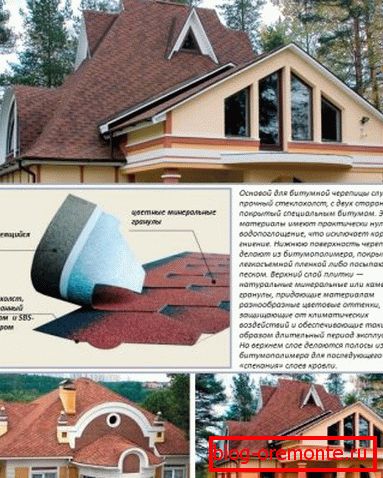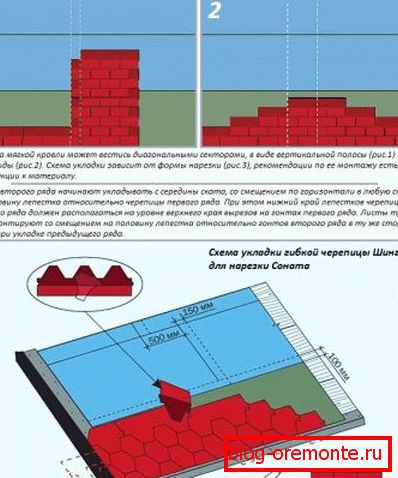Soft roofing, installation technology
In a very versatile category of "soft roof" combine flexible roofing materials, which are characterized by unsurpassed moisture resistance, weather resistance, reasonable price and ease of installation. Flexible coatings are essentially more modern analogues of roofing felt, they can be roll, piece or even liquid. Bituminous roofing materials have much in common, so the device of a soft roof is performed according to one algorithm. In this article we will talk about the process of preparing the truss frame and the sheathing for such a roof, as well as about the correct technology for laying the roofing sheet, which makes it possible to obtain a durable hydro-barrier.
Types of soft roof
The materials, combined by the term soft roof, are distinguished by 2 main features: flexible structure and the presence of modified bitumen or synthetic rubber in the coating. They are distinguished by light weight, ease of installation and a high degree of hydroprotection. Bituminous roof coatings differ in the form of release and the method of installation, according to these characteristics, they are divided into 3 categories:
- Roll cover. They are issued in the form of rolls 1 meter wide and 10-25 meters long. Roll coverings are roofing paperboard or fiberglass fabric impregnated with modified bitumen with protective coating, which are fixed to the base of the roof by fusing or gluing. This category includes traditional roofing material, roofing felt and membrane roofing.
- Piece materials. This type of soft roof includes shingles, which are also made of fiberglass impregnated with bitumen and sprinkled with stone chips. The flexible tile differs from rolled coverings in the fact that it is made in the form of tiles, small by the size, with figured edge, which width makes 30-40 cm, and length of 1 m.
- Roofing mastic. This group of materials includes bitumen-based liquid formulations with improvers and plasticizers, which are applied to the roof surface using a casting or painting method. Roofing mastic are hot, which must be melted before use, and hungry, fully ready for use.
Important! Laying soft roofing is performed on the roof of any slope and shape. It is possible to lay bituminous roofing materials on flat and low-angle roofs, as it creates an almost hermetic, moisture-proof coating. For roofs with a slope above 11 degrees, flexible tile is usually used, better suited for medium-sized structures.

Installation methods
Since flexible roofing coatings differ in the form of release, they need to be laid using different methods. Combines bituminous materials for waterproofing the roof simplicity and high speed installation. There are 4 technologies for securing a soft roof:
- Fusing. The method of fusing to the base of the roof are fixed bitumen roll materials. The bottom layer of roofing with such a composition is heated with a gas burner, as a result of which the bitumen melts slightly and adheres well to the crate, forming a durable, hermetic layer.
- Gluing. Polymeric roofing membranes are fixed to the crate by gluing. Adhesion occurs through a self-adhesive layer that melts at room temperature, or by using cold bitumen mastics.
- Coloring. Roofing mastic on the basis of bitumen is applied to the surface of a flat roof using a painting method. Using a spray gun, a roller or a wide brush, the roof is treated with them in several layers until a uniform, even and stable waterproofing coating is obtained.
- Fixing fasteners. You can fasten some types of soft roofing on the crate using roofing screws or roofing nails with a wide hat. This fixation technology is considered less reliable, as water can penetrate the mounting holes.
- Combined method. Roofing materials such as shingles are fixed using a combined method of fixation, combining the techniques of gluing and the use of fasteners.

Note! All types of soft roofing, except liquid, must be overlapped with obligatory overlapping of strips or tiles in order to prevent water from flowing into the joints between them. In addition, the laying of roll and membrane materials is carried out in several layers in order to increase the strength and service life of the roof covering.
Roof preparation
Technology laying soft roof consists of several stages, the most important of which is considered preparatory. Proper roof preparation for fixing the roofing material is a prerequisite for high-quality installation, tightness, and long service life. To proceed to the flooring of bitumen coatings, you must prepare:
- Rafter frame. Installation of a soft roof is made on the construction of any complexity. Rolled, membrane and liquid materials are suitable for flat and low-slope roofs, and flexible tiles are mounted on the slopes with a slope of 11 degrees. The rafter frame is made of dry wood, impregnated with an antiseptic or metal. Soft roof has a low mass, so you can use a lightweight frame.

- Waterproofing. A waterproofing film that protects the wooden frame from condensation and leakage is fixed on top of the rafter legs with the help of a construction stapler. The film is mounted perpendicular to the rafters with an overlap of 10-15 cm between the strips and a slight sagging that prevents breakthroughs of the material under the influence of water pressure.

- Crate. The basis for the installation of a soft roof should be solid and completely flat. It is possible to make a continuous crate from moisture-proof plywood, OSB boards or a rabbeted edged board. Between the sheets or boards leave a gap of 2-3 mm, so that when drying and shrinking, the roof frame of the roof can freely "walk".
- Lining carpet. The lining carpet is laid on the crate so that irregularities on it in the process of friction do not damage the shingles. On roofs with a slope of 11-18 degrees, it is mounted on the entire area of the slopes, and on steeper structures - only in places that are particularly vulnerable to leakage.
Remember that the step between the rafters, the thickness of the batten, the area of the lining carpet depend on the angle of inclination of the slopes. More gentle constructions need enhanced protection from moisture, since more precipitation lingers on the bottom, while snow slides off from slopes with a slope of more than 35 degrees.
Styling process
Styling process мягкой кровли зависит от вида используемого материала. Rolled coverings are stacked faster and easier than single-piece ones, however, shingles make it easy to overlap vaulted, pointed or even dome-shaped roofs. Installation of shingles is as follows:
- When the roof frame, lathing and lining carpet are ready for further laying of the roofing material, additional waterproofing of endov, ribs, ridge and knots is carried out to interface the roof surface with vertical surfaces.
- Using waterproofing material pasted overhangs design. Roll waterproofing is cut into strips, and then fixed to the crate along the overhangs so that it bends around it.
- Perform the installation of cornice and gable strips that protect the overhang from the penetration of water or wind. At this stage, you can attach the brackets for fixing the gutter.
- Equip with special housings or seals the place of the withdrawal of pipes or aerators through the roof surface.
- Then along the slope attach the eaves of the shingles, not having petals. It is fixed to the crate with screws or nails.
- After that, the first row of bitumen tile is laid, so that its petals overlap the eaves element. The fasteners are arranged in increments equal to the width of the petals. It turns out that in the upper part of the gont it is fixed with nails, and in the lower it is glued, creating a hermetic, integral coating.
- When moving to the second row of tile laying begin with the center of the slope, to align it horizontally.
- At the end, make up the ridge using a ridge aerator and a ridge element of soft tile.
Important! Installation of shingles should be performed at a temperature of +5 degrees or higher, otherwise it will not stick. The weather must be dry and windless so that water does not fall on the unprotected crate.


